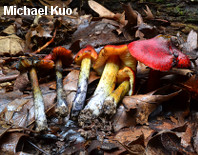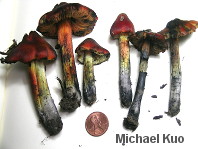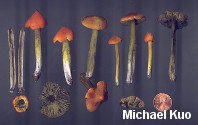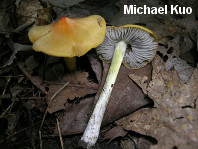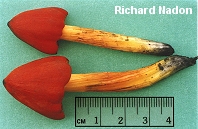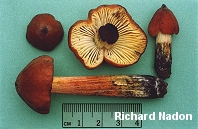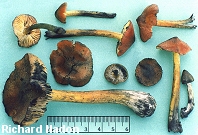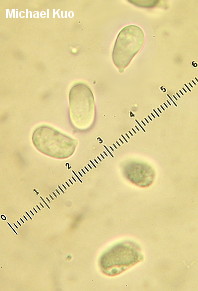| Major Groups > Gilled Mushrooms > Pale-Spored > Waxy Caps > Hygrocybe conica |

|
Hygrocybe conica [ Basidiomycota > Agaricales > Hygrocybaceae > Hygrocybe . . . ] by Michael Kuo Unlike many of the red and orange waxy caps in North America, Hygrocybe conica (sometimes called the "the witch's hat") is relatively easy to identify: virtually all parts of the mushroom bruise and discolor strongly black. In fact, one sometimes finds older specimens that have discolored so much that they appear almost completely black. Hygrocybe conica is currently treated by mycology as a highly variable species found in Europe, North America, South America, and Asia--in ecosystems of such diversity that listing them approaches being pointless. It seems unlikely to me that all of these mushrooms actually represent the same phylogenetic species--but the world still awaits an in-depth, detailed, DNA-based study of the conica group. Hygrocybe singeri, known in North America from the West Coast and the upper Great Lakes, is a similar blackening species with a slimy stem. Hygrophorus conicus is a synonym. Description: Ecology: Precise ecological role uncertain (see Lodge and collaborators, 2013); appearing in Midwestern woods under hardwoods, especially oaks--but reported by other North American authors under conifers, as well; growing alone or gregariously; early summer through fall (also reported in winter in warmer climates); widely distributed in North America. The illustrated and described collections are from Illinois and Québec. Cap: 1-4 cm across (occasionally up to 6 cm across); sharply conical at first, expanding to broadly conical, or broadly convex with a raised center or point; sticky when very fresh, but soon greasy or dry; bald or finely radially silky; bright red to bright orange, fading to orangish or yellowish; developing black and olive stains, and eventually becoming black overall. Gills: Narrowly attached to the stem; close or nearly distant; whitish to yellowish or yellow at first, becoming pale yellow, then orange; bruising and aging pale to dark gray or black; thick; short-gills frequent. Stem: 3-8 cm long; 3-10 mm thick (occasionally up to 20 mm thick); more or less equal; yellow to orangish yellow or orange, with a white base; fairly dry; fragile; splitting; often grooved lengthwise or twisted; hollow; bruising black. Flesh: Colored like the cap; thin; slowly blackening on exposure. Odor and Taste: Not distinctive. Dried Specimens: All parts blackening. Chemical Reactions: KOH on cap surface negative. Spore Print: White. Microscopic Features: Spores 7-11.5 x 4.5-6.5 µ; smooth; ellipsoid or occasionally somewhat constricted and irregular; hyaline to brownish in KOH; inamyloid. Basidia 4-sterigmate or 2-sterigmate; 40-60 µ long. Hymenial cystidia absent. Lamellar trama parallel. Pileipellis an ixocutis. All elements (including spores) becoming brownish to dark brown in KOH on blackened specimens. REFERENCES: (Schaeffer, 1774) P. Kummer, 1871. (Fries, 1821; Fries, 1838; Saccardo, 1887; Hesler & Smith, 1963; Bird & Grund, 1979; Smith, Smith & Weber, 1979; Largent, 1985; Arora, 1986; Phillips, 1991/2005; Lincoff, 1992; Metzler & Metzler, 1992; Horn, Kay & Abel, 1993; Evenson, 1997; Barron, 1999; Boertmann, 2000; Roody, 2003; McNeil, 2006; Miller & Miller, 2006; Trudell & Ammirati, 2009; Kuo & Methven, 2010; Lodge et al., 2013; Kuo & Methven, 2014.) Herb. Kuo 06019510, 06160207, 07220315, 07220316, 10030506, 06230903, 07300901, 07021303, 10141402. This website contains no information about the edibility or toxicity of mushrooms. |
|
|
Cite this page as: Kuo, M. (2014, March). Hygrocybe conica. Retrieved from the MushroomExpert.Com Web site: http://www.mushroomexpert.com/hygrocybe_conica.html ©MushroomExpert.Com |
